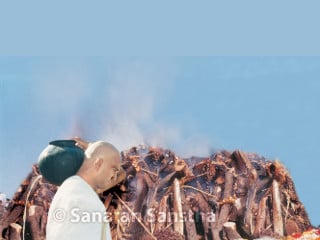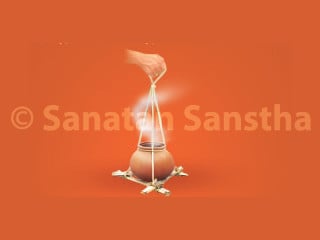Rituals after death
Below are some very common questions and doubts raised about some of the Hindu Rituals after death
1. Why is Gangājal (water collected from the river Gangā) poured into the mouth of a deceased followed by placing tulsī (basil) leaves in the mouth ?
Often, when the prān (vital energy) leaves the gross body, the mouth remains open, and through this open mouth, putrefying waves from the dead body spread into the environment. By pouring Gangājal and placing tulsī (basil) leaves in the mouth, Sattva waves from the Universe get attracted to these sāttvik objects placed in the mouth. This brings about disintegration of putrefying waves released from the mouth into environment, thus keeping the environment pure. Moreover, Gangājal and tulsī leaves help in retaining the purity of the inner sheaths of the deceased and in preventing entry of negative energies through the mouth. Hence this is treated as one of the prime rituals after death.
2. Why is a bunch of tulsī leaves placed in the nostrils and ears of the dead body ?
Instead of cotton balls, a bunch of tulsī leaves is placed in the nostrils and ears of the dead body. This prevents the subtle putrefying gases from spreading into the environment through the ears and nose, and the environment is purified too.
3. Whenever there is a death in the family, why is an earthen lamp lit in the house and what should be its direction ?
When the vital energy (prān) leaves the physical body, sub-vital energies and other subtle putrefying gases are released into the environment, and the person gets confined to that place with the physical body becoming lifeless. As a result, the Raja-Tama predominant waves associated with the sheath of desire of the deceased, move rapidly in a circular manner at the place of his death. There is every likelihood that any jīvas (individuals) entering the area encircled by these waves will suffer distress. To prevent this, an earthen lamp is lit on the precise spot. The flame of this lamp is kept facing the south, since that is the direction of abode of the Deity of death, Yama. After lighting the lamp, one should pray to Deity Yama thus – ‘O God, let the Tēj-tattva (Absolute Fire Principle) predominant waves emanating from you be attracted to the flame of this lamp. Let the waves emitted by this flame restrict and disintegrate all the Raja-Tama predominant waves associated with the dead body that are moving in the premises.’
A prayer made thus activates the flame and expels Raja-Tama predominant waves moving in a circular manner from the place. It is because of this reason that for the first five days, there is considerable amount of flickering of the flame. This flickering signifies its activated state. From the seventh day onwards, the flame becomes steady. The steadiness of the flame is an indicator of reduction in movement of Raja-Tama predominant waves in the premises due to their disintegration.Understanding the science behind rituals after death such as this helps in increasing our faith in the spiritual science associated with many such practices associated with death as per hinduism.
4. Why is a lit earthen lamp placed on wheat flour kneaded with water ?
An earthen lamp is lit on a mound of wheat flour kneaded with water. Due to the wheat flour mound, the Tēj-tattva predominant waves attracted to the flame are held for a longer period and then they are gradually emitted far and wide as per the need. This helps in formation of a subtle-layer of Tēj-tattva predominant waves on the floor, which in turn helps in reducing the obstruction of negative energies from the Pātāl region (Hell region) in disintegration of Raja-Tama predominant waves, and the process is completed without any obstacles. Complete destruction of Raja-Tama predominant waves reduces the chances of the deceased getting entrapped in Bhulok (Earth region).
5. Why is only one wick used in the earthen lamp ?
Once a person dies, his body, which is made up of the five Cosmic Principles, becomes lifeless; then it is only the soul that glows. A single wick used in the earthen lamp is a symbol of the glow of the soul.
6. Why is the dead body bathed and then dressed in new clothes ?
Bathe the dead body accompanied by loud chanting of ‘Shrī Gurdēv Datta’. Due to the Sattva waves spreading from the hands of the person chanting the Name, the water gets charged with these waves and the environment is purified. Bathing a dead body with water charged with sāttvik waves destroys the sheath of Raja-Tama particles on the dead body, so also it helps in releasing the subtle putrefying gases trapped in the body. Thus, bathing the deceased amounts to purifying him/her externally as well as internally. After the bath, the deceased should be dressed in new clothes. The clothes should first be purified by holding them over fumes of dhoop (frankincense) or by sprinkling them with gomutra (cow’s urine) or tīrtha (sacred liquid). Through the medium of these new clothes a protective sheath is formed around the deceased. Hence this is one of the important aspect within the many rituals after death as per Hinduism.
7. Rituals after Death – Why should the dead body be preferably cremated during the daytime ?
The dead body should preferably be cremated during the day time because cremation is a Tama-predominant act. Since night is related to Tama component, the proportion of negative energies which themselves are Tama-predominant is high during this period. This period is conducive to the attacks of negative energies and therefore, if cremation is done during night, it can cause hindrance to attaining of momentum before death by the linga-dēha (subtle-body) of the deceased. Besides, due to the increased level of attacks of negative energies on the linga dēha, it is likely to be overpowered by the negative energies. Therefore, the process of cremation of a dead body during the night time is considered as inappropriate.
8. Rituals after death – Why are only bamboo sticks used for making a bier ?
The hollow of the bamboo stick has sound energy, which moves in a circular manner. The sound waves emitted by this sound energy create subtle flames of fire in the atmosphere. Keeping the dead body on the bier is in effect keeping it in space charged with these waves, and it results in formation of a protective sheath around the dead body. The bier is placed on the floor, so a subtle covering is formed on the floor as well; thus protecting the dead body from distressing waves emitting from the Hell region. Thus, using bamboo sticks for making the bier helps in restricting negative energies that try to come close to the dead body.
9. What is the science underlying the act of laying the deceased on his back and tying his big toes together, before taking him/her to the crematorium ?
Before taking the deceased for cremation, the dead body is laid on the floor horizontally and the big toes are tied together. This helps in conjoining of the right and left energy channels, leading to movement of the waves from the body in a circular manner within the body itself. This effects complete restriction on the emission of waves that is based on the residual subtle energy present in the body at the time of death, and the process of spreading of the waves is enhanced. In this state, the flow of waves from both the sides (that is, the left and right) of the dead body is equal. Hence, pressure is exerted on the centre point of the human body (that is, the navel) and the subtle putrefying gases that remain trapped in the voids of the body are forcefully pushed in an upward direction and are expelled through the mouth or through the nose or they stabilise in the hollow of the skull and are expelled in the process of breaking of the skull during cremation.
10. Why is a pitcher (mud pot) carried to the crematorium along with the dead body ?
Through flow of sound waves emitting from the sound energy that has converged into the pitcher, Raja-Tama predominant waves are generated around the dead body. Hence, the dead body is continuously protected from negative energy attacks. The coal embers in the pot emit Tēj-tattva predominant waves, which in turn create subtle sound waves. These sound waves get activated and are released into the environment with great speed. The waves related to Tēj-tattva emitting from the fire in the pot, continuously disintegrate the Raja-Tama laden waves in the atmosphere. In addition, it also helps in restricting the free movement of the subtle warm gas that is generated due to friction of Raja-Tama laden waves. It is because of this, that there is constant purification of the surrounding environment, thereby reducing the possibility of distress caused by negative energies to people accompanying the dead body.
11. Why should everyone chant ‘Shrī Gurudēv Datta’ aloud while carrying the dead body to the crematorium ?
The function of the Datta Principle is to impart momentum to the linga-dēha of ancestors. Hence, by chanting the Name of Deity Dattātrēya, the linga-dēha of the deceased and also those of his ancestors that are wandering in the atmospheric boundaries, gain momentum in lesser time.
12. What is the science underlying consigning the dead body to the flames ?
Fire is related to Tēj-tattva. Chanting of the mantras generates sound energy. Sound is related to Ākāsh-tattva (Absolute Ether Principle), on the strength of which waves emitting from the fire gain greater momentum. The combined waves that are generated as a result of union of Tēj-tattva with Ākāsh-tattva creates a subtle impenetrable sheath around the dead body. This sheath helps protect the linga-dēha (now wandering in the atmosphere) from negative energies. Also, combined waves (as explained above) generate subtle heat due to which the linga-dēha is able to break the barrier of the atmospheric sheath of the earth region and move into other regions in a very short time. Thus, the lighting of the pyre amidst chanting specific mantras for the disposal of the dead body has tremendous importance. On the other hand, a jīva which does not have the fortune of benefitting from such a strong sheath around its linga-dēha (achieved by the process of cremation) suffers the misfortune of falling into the clutches of the sorcerers (The most powerful demoniacal energies) and becomes their slave. Such an unfortunate jīva may remain trapped for years together in the same species, enslaved to the sorcerers.
13. After cremation of the body on the funeral pyre, why should the performer of the rites circumambulate around the pyre thrice, holding a pitcher containing water on the shoulder and letting water flow from it while circumambulating ?
Holding the pitcher on the shoulder symbolises shouldering the responsibility of repaying the debts of the deceased. The pitcher symbolises the gross body of the embodied soul. Making a hole in the pitcher is akin to making an opening in his body in the final stage for expulsion of subtle putrefying gases and Raja-Tama waves in desire form. When water flows from the hole in the pitcher, the waves in this water gain momentum and generate frictional heat that disintegrates the Raja-Tama particles, thereby purifying the surrounding area. Due to the Āpa-tattva (Absolute Water Principle) laden waves emitting from water, sound waves which have congregated in the pitcher, are also quite effectively passed into the atmosphere and are kept in an active state as per the need. Circumambulating the pyre thrice when letting water flow from the pitcher amounts to making an effort to draw a subtle ‘manḍal’ (sheath) around the pyre at three different levels and making an attempt to liberate the linga-dēha from three major desires. These three levels originate from God’s resolve through the medium of will, action and knowledge waves. In addition, it also amounts to purification of the atmosphere surrounding the pyre. Liberation from the three major desires is as follows – (i) Liberation from the desire of will is liberation from the bondage arising out of a promise given to someone. (ii)Liberation from the desire of action is liberation from unfulfilled duties, and (iii) Liberation from desire of knowledge means liberation from the subtle desire of the fruit arising out of fulfilment of a duty. This act of letting water flow out thrice represents elimination of all desires of the linga-dēha and is an attempt to prevent it from getting trapped in these bondages again. Circumambulating the pyre accompanied by letting the water flow out amounts to making a subtle vow that the son of the deceased is being made to perform the ritual to free him from debts unto ancestors. This is done to help the deceased gain momentum in his further journey.
14. Why is the ritual of pinḍadān (offering of balls of cooked rice) performed on the banks of a river ?
As the physical body is lost after death, proportion of Pruthvī-tattva (Absolute Earth Principle) from the sheath surrounding the linga-dēha reduces and that of Āpa-tattva in it increases. The constitution of the sheath of the linga-dēha is such that the level of subtle humidity in it is maximum. Since these rituals performed are related to the linga-dēha of the deceased, to facilitate its re-entry into the atmosphere of the earth, the ritual of pinḍadān is performed on the banks of a river, where the humidity is high due to greater proportion of particles of Āpa-tattva in the atmosphere. Hence, this atmosphere when compared with any other, is much more familiar to and is liked by the linga-dēha and it gets attracted to it quickly. This is the reason why all post-death rites like pinḍadān should ideally be performed on the banks of a river.
14A. Why is the ritual of pinḍadān performed in a temple of Deity Shiva or an inferior Deity on the banks of a river or a ghāt ?
Generally, the ritual of pinḍadān is performed in a temple on the banks of a river or a ghāt (Steps on the banks of a river). Often these are temples of Deity Shiva or those of inferior Deities. This is because, in the premises of their temples, these Deities exercise control over the negative energies. This helps in protecting the linga-dēha from being obstructed during its arrival into the atmosphere of the earth. Hence, during the ritual of pinḍadān, the Deity is invoked and is prayed to, to prevent negative energies from attacking the linga-dēha and taking control of it before arriving into the atmosphere of the earth for the ritual.
15. Why are the asthī (bones) collected on the third day after cremation ?
The heat generated due to the fire that is lit while reciting mantras (which is in effect spreading of the combined waves of Ākāsh -tattva and Tēj-tattva in the asthī) reduces progressively after the third day of cremation. Consequently, the potential of the sheath (created around the ashes) to protect them also reduces proportionately. In this state, negative energies can perform various rituals on the asthī and thereby trouble the linga-dēha. These negative energies can also torment relatives of the deceased through the medium of the linga-dēha. That is why, the asthī are collected on the third day from the Raja-Tama predominant environment of the crematorium.
16. Why is it considered important for a crow to partake of the offering of the pinḍa (Cooked rice ball) during the ritual of pinḍadān done on the 10th day after death ?
Kākgati’ (Kāk means crow, gati means momentum) symbolises the momentum of the linga-dēha that enters the atmosphere of the earth for the ritual after being invoked. Since the colour of the crow is black, it represents the Raja-Tama predominant ritual of pinḍadān. The subtle sheath surrounding the crow has high humidity similar to that surrounding the linga-dēha. This similarity facilitates the entry of the linga-dēha into that of the crow. Linga-dēhas that have many desires get entrapped in Bhulok (Earth region), in Martyalok (Region of the dead), Bhuvalok (Nether region) and Swargalok (Heaven region). After entering the atmosphere of earth, such linga-dēhas enter the body of a crow and partake of the pinḍa. The pinḍa located in the centre of all other pinḍas is connected to the linga-dēha of the deceased, hence the crow’s partaking of it is considered to be of great significance. The linga-dēha gets gratified both at the physical level (by consuming the pinḍa through the medium of a crow) and at the subtle level (by absorbing the subtle gas liberated from the pinḍa). This provides the soul with energy at both, the gross and the subtle levels, to thrust itself out of the atmosphere of the earth. The gross energy nurtures the outer sheath of desires of the linga-dēha, while the subtle energy provides the linga-dēha with the inner strength to continue in its further sojourn.
Reference : Sanatan’s Holy Text, ‘Death and post-death rites’


 Rituals to be performed prior to and during cremation of a dead body
Rituals to be performed prior to and during cremation of a dead body Rituals to be performed after cremation till the 13th day after death
Rituals to be performed after cremation till the 13th day after death In which direction should the dead body be placed before taking it to the crematorium ?
In which direction should the dead body be placed before taking it to the crematorium ?